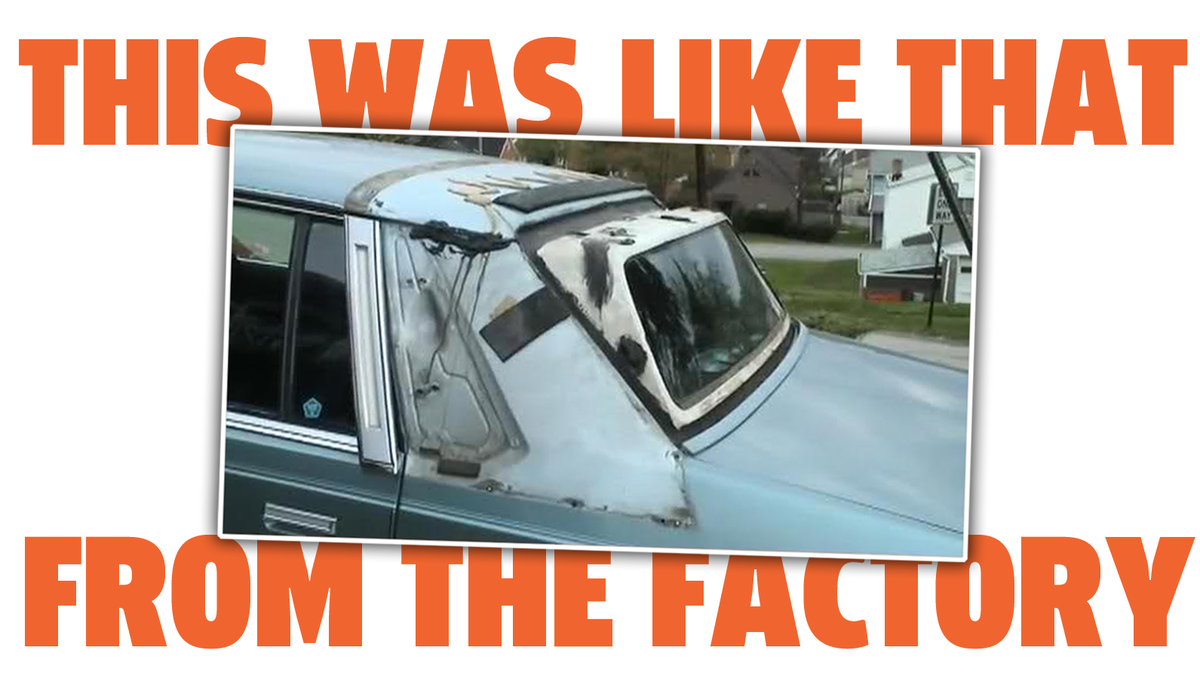Remember, The Past Was Garbage: Chrysler Edition

Screenshot: Reddit
What I’m about to describe to you is one of those things that manages to short-circuit my brain when it comes to how I perceive it: On the one hand, it was ridiculous garbage and should have been embarrassing to the companies that did this. But at the same time, it was wildly clever and did exactly the job it was intended to do. The paradox I’m describing is the old 1970s and ‘80s-era practice of re-designing a roofline with fiberglass and industrial goops, then hiding it all under vinyl.
I’ve actually been looking into this fascinating, forgotten practice for a while, as I’ve reached out to Ford to try to get more information about how the Granada was classied-up into the 1979 Lincoln Versailles via the use of a fiberglass cap to re-work the roofline:
Image: Ford/Lincoln
You see, the first version of the Lincoln Versailles had the same sloping roofline of the cheaper Ford Granada, and Ford decided that the discriminating Lincoln buyer was the sort of ultra-classy sort of person that laid roses on piano keyboards next to champagne flutes and shit like that, and as such would not stand for having the same miserable, sloping roofline that the dirt-eaters who bought Granadas would. So, Ford contacted the American Sunroof Company to make them a new roof end cap, then covered it all in classy-ass vinyl, the results of which you see up there.
What I wanted to see was what this all looked like under the vinyl; how did Ford actually cram on these new roof caps? I reached out to Ford to see if they had any sort of pictures of the process from their archives but so far have gotten no response.
Fortune was in my favor, though, because I’ve finally seen what one of these types of cheap-ass transformations looks like, thanks to someone who posted this on Reddit’s Regular Car Reviews forum:
Screenshot: Reddit
Now, this isn’t Ford’s Versailles solution, this is 1980s Chrysler craftsmanship, where the bodyshell of the Dodge 600/Plymouth Caravelle/Chrysler E-Class was transformed into the Chrysler New Yorker without having to stamp any new body panels or anything like that.
You can see the baseline body shell in the foreground of this ad and the New Yorker’s modified roofline in the rear:
Image: Chrylser
See what they did there? Let’s take a look at this handiwork again—and, remember, this was how it was from the factory. The vinyl cover was just removed, and this was what was below:
Screenshot: Reddit/Chrysler
The vinyl roof craze on cars from the ‘60s to the ‘80s is pretty baffling until you think about it in this context: vinyl roofs presented a remarkable opportunity for car designers to make cheap, rapid, and pretty significant changes to body designs without the cost or complexity of stamping new body panels.
The vinyl was fantastic at hiding sins, and carmakers took advantage of this. Just look at how that’s been handled up there: The new rear window assembly in its fiberglass housing has been shoved into the existing window hole, the rearmost quarter window has been plugged with a stamped chunk of sheet metal, and lots of that black butyl tar/rubber sealer goop has been generously slathered over everything.
I can’t imagine any carmaker trying to get away with something like this today, and while this does look kind of appalling, you have to admire the ingenuity of it all.
If you’ve already managed to convince people that, somehow, upholstering the outside of your car’s roof looks cool and classy, then why not take advantage of that? Jam some chunks of fiberglass onto your car and get a whole new look on the cheap! Win-win for everyone!
Chrysler was kind of a master of this kind of stick-on fakery in the 1980s. Look at this example, which has the added excitement of being taillight-related!
Screenshot: Chrysler
So, the Dodge 600 was the fancified version of the Dodge Aries K-car. It was actually kind of handsome, especially the front end, but I want to talk about the rear right now.
The 600 started off with these pretty simple, three-section taillights. A couple of years into production, modern styles changed to make larger, wraparound taillights popular, where taillights would wrap around the rear corners of the car, usually integrating the rear side marker lamps into them for a cleaner look.
Dodge wanted to have these new style lamps and in 1985 did a minor facelift (buttlift?) that included them. But you’ll notice that rear side marker lamps are still separate. Why’s that?
Well, that’s because the new taillights were built like this:
Screenshot: eBay
See what’s going on there? Once again, Chrysler was too cheap to actually re-design the sheet metal to accommodate the larger, wraparound lights, so they just shoved them in the existing smaller holes and made the overlapping and wrap-around bits hollow and just covering the exterior sheet metal of the car.
They’re sort of fake, and Chrysler used extra chrome trim pieces wrapping around the sides and top of the lamps to hide that the gaps that were created when the shoved a bigger taillight into a smaller hole.
Again, chintzy — but very clever. They did improve the look of the rear, and, really, I bet most owners never realized or cared that the rear corner of their taillights did nothing.
It’s great to be nostalgic for the past, but I think it’s good to remember all of the half-assed stuff, too. I even think it gives these cars more character, because they are, like all of us, flawed, and just trying our best.
(thanks, Hans!)







